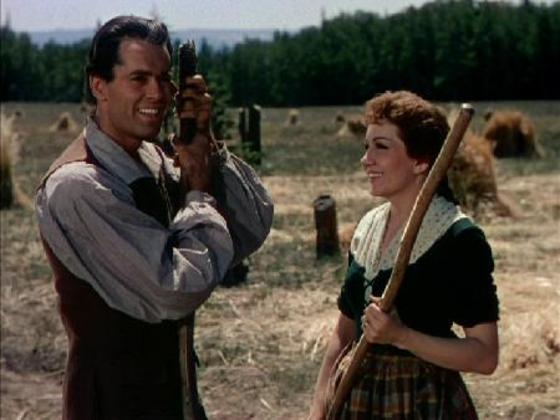 John Ford's first color film is set in 1776. Gilbert Martin (Henry Fonda) and his wife Lana (Claudette Colbert) leave Albany and settle on the frontier, in the Mohawk valley in New York. What seems like an idyllic life is soon destroyed by the intrusion of the Revolutionary War.
John Ford's first color film is set in 1776. Gilbert Martin (Henry Fonda) and his wife Lana (Claudette Colbert) leave Albany and settle on the frontier, in the Mohawk valley in New York. What seems like an idyllic life is soon destroyed by the intrusion of the Revolutionary War.
The first Indian to appear is Blue Back (Chief Big Tree), a friendly Christian convert, who often stops by to visit and speaks in the stereotypical broken English that makes him appear a little slow. "Sure. Much rain." "Me go hunting. Bring you half deer. hang outside." "Me go now. Come back again, maybe." Ford then uses a joke that he also later uses in the Quiet Man. Blue Back gives Gilbert a stick telling him to "Lick her good. Make her a fine woman." Somehow, it doesn't play too well today.
They build a log cabin and work on their farm. Things are going well, until the bad Indians appear. An eye-patch wearing British agent named Caldwell (John Carradine) leads screaming savages as they ravish the country side and destroy the Martins' farm. The British angle is played down, since it is 1939, and the English were already fighting the Nazis in Europe. So Ford made his villain one man, Caldwell, the leader of mindless, scary, screaming savages.
Blue Back comes and says: "Indians on warpath. Coming." While the settlers flee to the fort, the Indians swoop in dancing, yelling and burning. Gil and Lana move in with the widow, Mrs. McKlennar (Edna May Oliver), who provides typical Ford comic relief, and steals most of the scenes she is in. The militia marches off, and when they return, Gil is wounded, and many are dead.
Two drunk Indians come in to the house and Mrs. McKlennar fights with them in a somewhat comic scene. The Indians laugh hysterically as they burn the house down. Thousands of Indians are on their way and everyone flees to the fort again. The screaming Indians, led by Caldwell, attack the fort but the settlers hold them off. Caldwell, now dresses in a British uniform, says: "Call the filthy beggars back." No one appreciates the Indians in this movie.
Joe (Francis Ford) attempts to run for help, but is caught. He is then set up in front of the fort and is set on fire, in a very scary scene. The Reverend then shoots Joe to put him out of his misery. Gil then runs for help, with the "filthy, painted heathens" following, in a scene that would later be mimicked in The Naked Prey, Run of the Arrow and Apolcalypto. He knows what will happen to him if he is caught.
This was not one of John Ford's best depictions of Indians. This was the same year that he made Stagecoach and in both movies we have the Indians represented as a screaming savages, just interested in destruction and killing. Ford would make up for it in more balanced movies like Fort Apache, The Searchers, and Cheyenne Autumn. In Drums Along the Mohawk, the Indians portrayal fell victim to Ford's sense of patriotism, as the English were let off easy. Someone had to be the bad guys.
Drums Along the Mohawk is a pretty good movie, but it definitely does not present a reasonable or balanced portrayal of the Indians. Still, it is a movie worth seeing just to see how Indians were often portrayed in early American films.
|